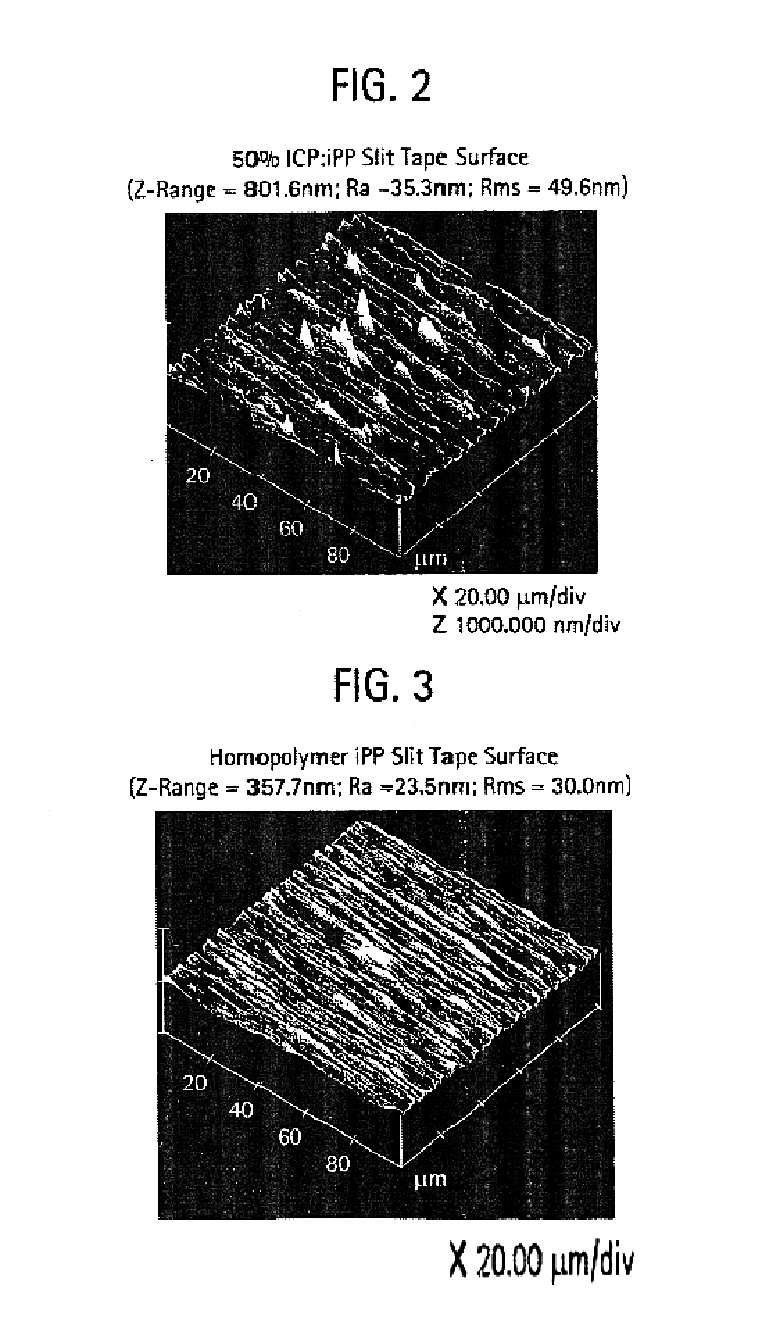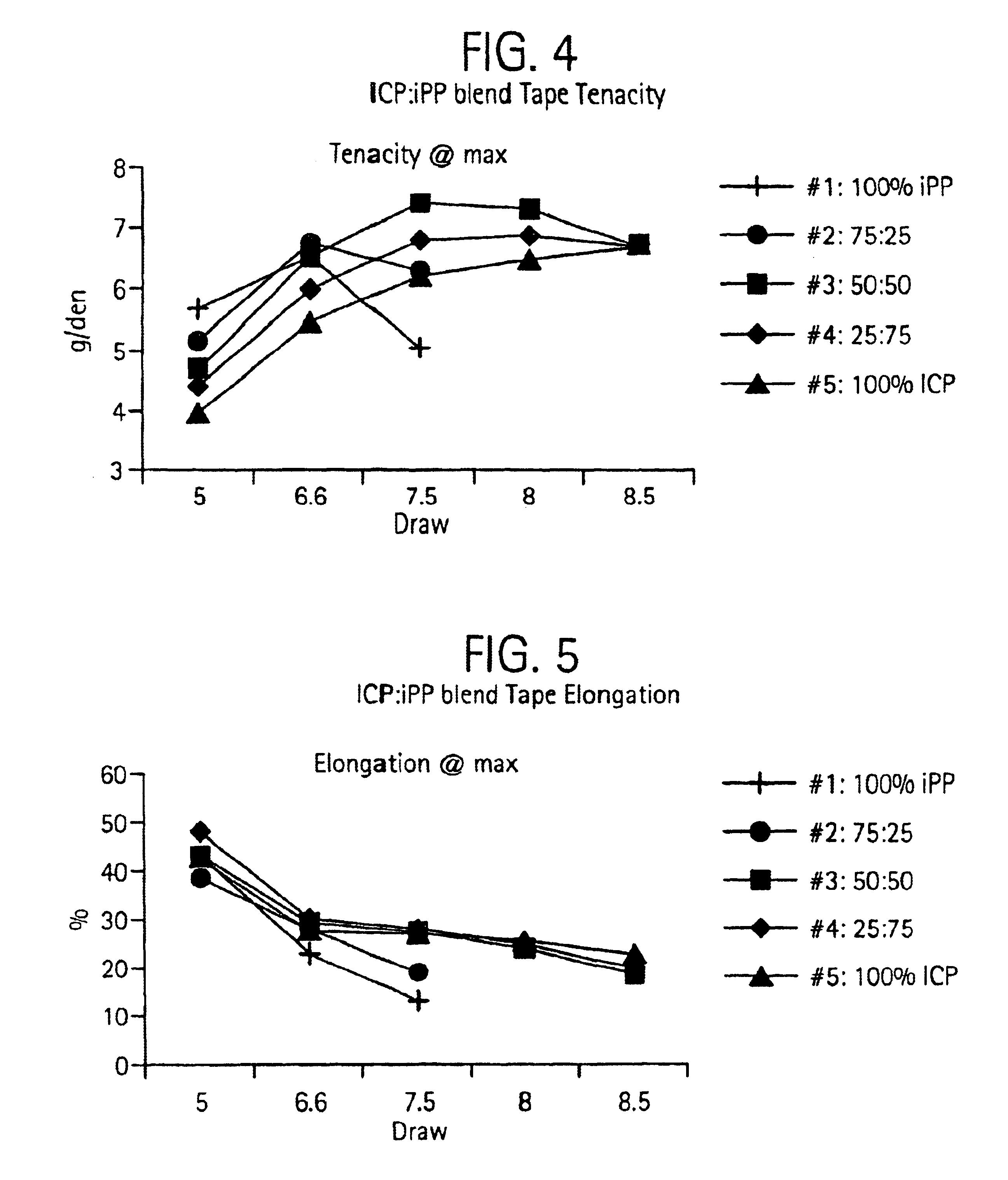Polyproplylene materials and method of preparing polypropylene materials
a polypropylene and material technology, applied in the field of polypropylene materials and preparing materials, can solve the problems of reducing extrusion efficiency, reducing loom efficiency, and a higher level of fabric defects
- Summary
- Abstract
- Description
- Claims
- Application Information
AI Technical Summary
Benefits of technology
Problems solved by technology
Method used
Image
Examples
example 1
[0041]Polypropylene resins prepared from Ziegler-Natta catalysts were used in the evaluations. Specifically, ATOFINA 3365 was used as the polypropylene homopolymer and ATOFINA 4320 was used as the impact copolymer, which had a room temperature (23° C.) notched IZOD impact strength of approximately 4.2 ft-lb / in. The polymers further had the following properties, as set forth in Table 1 below. Different blend formulations were used as set forth in Table 2, using the iPP homopolymer as a control. A Bouligny slit film tape line was used in the study, with typical process parameters being set forth in Table 3.
[0042]
TABLE 1 Resin CharacteristicsOverall*EPR* phaseMFRWt. %Wt. %Resin(g / 10 min)C2=C2=iPP3.80N / AICP3.79.544.7*C2 content as measured by carbon NMR.
[0043]
TABLE 2 ICP:iPP Blend Formulations (wt. %)1Formulation:(control)2345iPP1007550250ICP0255075100
[0044]
TABLE 3Line SettingsTape Line SettingsDenier1000Barrel profile (F)390-482Die (F)482Die Gap (mil)15Air Gap (in)1Water Bath...
example 2
[0053]Impact copolymer-homopolymer blends were used in forming fabric materials using varying amounts of ICP and iPP. The ICP material used was ATOFINA 4320. The iPP homopolymer used was ATOFINA 3367V. Both were prepared from Ziegler-Natta catalysts. The ATOFINA 4320 used had a room temperature (23° C.) notched IZOD impact strength of approximately 4.2 ft-lbf / in. The polymers further had the following properties, as set forth in Table 5 below.
[0054]
TABLE 5 Resin CharacteristicsOverall*EPR* phaseMFRWt. %Wt. %Resin(g / 10 min)C2=C2=iPP2.800ICP3.79.544.7*C2 content as measured by carbon NMR.
The fabric materials produced utilizing the ICP / iPP blends had dramatically improved strength properties over that produced with no ICP.
example 3
[0055]Slit tapes were prepared from both an impact copolymer-homopolymer blend and an iPP homopolymer to evaluate surface roughness without delustering. The tapes were prepared using a draw ratio of 6:1. The polymer blend was formed from a 50:50 ICP:iPP blend of ATOFINA 4320, as the ICP, and ATOFINA 3462 as the iPP. This was compared to ATOFINA 3462 as a homopolymer. Surface properties of the tapes were measured Nanoscope atomic force microscopy (AFM) tapping mode. The following results were obtained, as presented in Table 6 below.
[0056]
TABLE 6HomopolymerICP:iPP BlendRunZ-RangeRa (nm)Rms (nm)Z-RangeRa (nm)Rms (nm)1562.0852.91763.8841347106.57134.582818.3562.1179.1991230137.33169.393673.9165.33279.6191526117.72154.084609.256.83373.108113897.774123.75919.0855.3371.0661084111.88140.386593.8461.88780.9711266117.85151.39Avg.696.159.174.61265.2114.9145.6
[0057]The slit film tapes can be used in a variety of products that require a high degree of durability and toughness. The slit film tape...
PUM
| Property | Measurement | Unit |
|---|---|---|
| Fraction | aaaaa | aaaaa |
| Fraction | aaaaa | aaaaa |
| Fraction | aaaaa | aaaaa |
Abstract
Description
Claims
Application Information
 Login to View More
Login to View More - R&D
- Intellectual Property
- Life Sciences
- Materials
- Tech Scout
- Unparalleled Data Quality
- Higher Quality Content
- 60% Fewer Hallucinations
Browse by: Latest US Patents, China's latest patents, Technical Efficacy Thesaurus, Application Domain, Technology Topic, Popular Technical Reports.
© 2025 PatSnap. All rights reserved.Legal|Privacy policy|Modern Slavery Act Transparency Statement|Sitemap|About US| Contact US: help@patsnap.com



